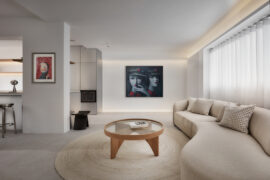
Paralympian Theresa Goh and Chalk Architects offer a blueprint for designing spaces that embrace independence and celebrate individuality.
19 December 2024

Text by Vanitha Pavapathi
Creating a home for individuals with physical disabilities is more than just adding ramps or widening doorways. It demands a design that fosters independence, celebrates personality, and accommodates evolving needs. The new home of Singapore’s first Paralympic swimmer, Theresa Goh, designed by Chalk Architects, demonstrates how thoughtful design can create an inclusive and inspiring space for both abled and disabled residents.

For Theresa, space is freedom. Her previous two-bedroom condo fell short of her needs due to limited space. “Just one extra item that took up floor space meant I had less turning room in my wheelchair,” she recalls. Her new four-room flat boasts nearly double the floor area with generous circulation, turning what was once a limitation into a liberating feature.
As Chalk Architect’s lead designer Charmaine Wong explains, “We designed the kitchen, dining, and living areas in the HDB flat as one open plan to ensure unobstructed circulation and this makes regular hosting of friends and family more enjoyable.”

Aside from spatial planning, Theresa emphasises the importance of testing and customisation in the design process. “I tested the sofa before purchasing because I needed to ensure I could transfer easily from the sofa to my wheelchair,” explains the retired Paralympian and bronze medallist. “Counter heights were measured. Everything was measured.” This included knee space allowance too.

The home is tailored not only for Theresa but also for her able-bodied partner, Kethlyn. Kitchen counters, for example, are set at varying heights to accommodate both users comfortably. “Our design allows for variety and options,” explains Charmaine. “Electrical switches and outlets are strategically positioned at both standard and lower heights, making the space user-friendly for everyone.”
Accessibility doesn’t stop at counters and switches. Features such as a stowable ironing board, a pull-down dish drying rack, and a pull-out tabletop make everyday tasks manageable and efficient. Voice-activated home automation adds another layer of convenience, empowering Theresa to control lights, appliances and other systems effortlessly.

Privacy for individuals with physical disabilities is often underestimated, with the assumption that caregivers are always on hand to assist. However, preserving independence and dignity is paramount for many. Privacy doesn’t have to mean isolating spaces entirely. In Theresa’s home, translucent panels strike the perfect balance by offering screening while allowing light to filter through. These panels create a soft interplay of blurry silhouettes, maintaining a sense of openness while ensuring personal spaces remain discreet and dignified.

An inclusive home extends beyond addressing specific user needs. “It can be characteristic, showcasing the personalities and quirks of the residents,” expresses Charmaine. This principle is evident in the playful use of dichroic glass, which creates dynamic rainbow hues that shift throughout the day, adding a vibrant and cheerful atmosphere to the home.
The couple’s love for cats also shines through. “Happy cats, happy life,” they declare, and the home reflects this ethos with a feature wall of ledges in the dining area, creating a playful backdrop and a space for their feline companions to explore.

Chalk Architects designed the home with adaptability in mind to minimise future costs and disruptions. Built-in carpentry is kept at a minimum with pull-out and pull-down mechanisms that can be changed easily. Loose furniture, such as a system pole wardrobe and a mobile television stand, allow the homeowners to reconfigure spaces as their needs evolve. Not to mention, the open-plan layout in the common area enables easy modifications over time.
The flat’s design also aligns with Singapore’s push to encourage seniors to age in place. Many of the features, like seamless circulation and accessible cabinetry, are transferable to homes for the elderly. “Safety and accessible features can be seamlessly integrated with early planning, creating a universal home where the young, elderly, able-bodied, and disabled can co-live comfortably,” Charmaine adds.

For Theresa, the renovated space has been life-changing. “The feeling of freedom in a home cannot be understated. I can do most things now, and if I can’t, I know I can ask Kethlyn for help,” she says.
Her advice to others planning accessible renovations? “Think of it as futures thinking. Try to imagine the space and how it feels to live in it. Some things you’ll only know work – or don’t – once you try.”
Chalk Architects
www.chalkarchitects.com
Photography by Benny Loh of Studio Zeros
We think you may also like Designing for special needs: A family’s home renovation journey
Like what you just read? Similar articles below

With clever carpentry, hidden storage and a seamless open-plan flow, this $111K transformation by Happe Design Atelier proves resale flats can be every bit as stylish and functional as new builds

Vipha House by Anonym Studio welcomes the presence of light and nature in architecture that is intentionally transparent.